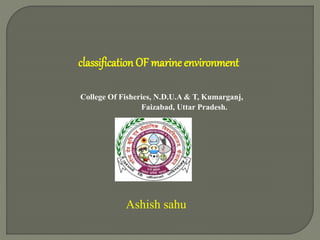
Classification and Zones of the Marine Environment
- 1. classification OF marine environment College Of Fisheries, N.D.U.A & T, Kumarganj, Faizabad, Uttar Pradesh. Ashish sahu
- 2. Introduction . Marine topography. Marine environment. Classification of marine environment. Pelagic environment. Benthic environment. Marine organism.
- 3. The ocean occupies 71% of the world surface. Marine ecosystem are the largest of earth’s aquatic ecosystem. Contains the largest amount of biomass. Marine habitat can be divided into two part:- pelagic and benthic habitats.
- 4. Marine enviroment include coastal like estuaries and wetland and oceanic landform from deep sea. The submerged surface has feature include as well as undersea, volcanoes, oceanic trench, sub marine canyon, and abyssal plains. Continental shelf is less than 200m deep.
- 5. Pelagic zone include the entire of water mass from sea surface. Pelagic environment are divided into two part. A –Neritic habitats B – Open sea habitats. Neritic zone extends from sea shore to the continental slope. Ocean extends from the shelf break & cover the entire ocean.
- 6. o Neritic extends from shore line to the point of continental shelf. It cover the water mass of the continental shelf. The water extends 200meters depth. Neritic zone is more productive because several energy such as tidal water and wave.
- 7. • Open ocean extend from the continental slope and covers the entire ocean. • The open ocean has low nutrient levels and supports only the smallest species of phytoplankton. • Still, because of its enormous area, most photosynthesis on Earth occurs in the sunlit top 200 meters of the open ocean.
- 8. Horizontal: Neritic | oceanic Vertical: Epi pelagic 0-200 meter depth Me so pelagic 200-1000m depth Bathypelagic 1000-4000 m depth Abysso pelagic 4000-6000m depth Hadal zone 6000 to the bottom depth
- 10. Epipelagic zone extends from the ocean floors 0-200m depth. Sun light is abundance. 90%of the all ocean life live is epipelagic zone. Fauna include many species of fish and some mammals, such as whales and dolphins. Many feed on the abundant plankton. Species in these zone tuna, dolphin, blue whale.
- 11. ‘Twilight zone" of the ocean Depth from 200m-1000m . • Some light is as deep mesopelagic zone. • Species lantern fish, squid, wolf eel, cuttle fish. Food becomes scarce – some animals • Migrate up to the surface at night to feed • Rely on food that falls down from above
- 12. Big Scale - ambush predator ctenophore – related to jellyfish cilia can be illuminated Firefly squid three kinds of photophores Hatchet Fish only a few inches long Viperfish specially adapted hinged skull Dragonfish - stomachs hold big meals Snipeel up to 1.2m Siphonophores are colonies of animals related to jellyfish best known is Portugese Man of War
- 13. Extends down from 1000 to 4000m. Only light is from bioluminescent organisms Only food is trickles down from above, or from eating other animals. Water pressure at this depth is considerable (~100 – 400 atmospheres). Most animals are either black or red in color.
- 14. Narcomedusa Vampire Squid Snake Dragon Angler Fish Amphi - crustacean Ctenophore – voracious predator Deepstaria very slow swimmers, no tentacles, close flexible bells (up to a meter across) around their prey Big Red grows to over a meter across
- 15. 4000m to 6000m the sea floor. Only zone deeper than this is the hadalpelagic zone. • Areas found in deep sea trenches and canyons. These zone also characterised by continous cold and lack of nutrients. • species in these zone angler fish and giant squids.
- 16. Deep Water Squid Shrimp Deep Sea Smoker - 648°F Basketstar Sea Pig Sea Spider Winged Sea Cucumber Medussa Deep-sea Anemone Hydrothermal Vent
- 17. The deepest pelagic zone between 4000- 6000m depth. It is also known as biozone. Low temperture in this zone. Hadal zone has low population and low diversity. Common organism includes jelly fish, sea cucumber, viper fish.
- 19. The benthic zone between high tide and low tide. littoral zone is a part of sea ,that is closed to the shore. Three sub region namely, supralittoral (splash zone), eulitroral (mid littoral), sublittoral (sub tidal zone).
- 20. Bottom Dwellers • Anchor to one spot: barnacles, oysters • Burrow in mud or sand: worms • Walk on bottom: Lobsters, crabs Habitats: • Intertidal zones, rocky shores, tide pools • Muddy Sandy communities • Deep ocean/ coral reefs • Hydrothermal vent areas
- 22. Depth 1000-4000m It is also known as mid night zone because of lack of light. These zone extends to benthic zone on the ocean bed of the continental slope. Many form of necton live in zone such squid, large whale, octopus.
- 23. Depth 6000m at the bottom of the ocean. Biomass decrese to a very small amount. Hadal zone has low population and low diversity. Low temperture. Common organism jelly fish, viper fish, sea cucumber.
- 24. Abyssal zone that contains very deep benthic near the bottom of ocean. Abyssal zone cover more than 50% of the earth. Absence of light. Food in benthos .
- 25. Marine organisms can be classified into one of three groups based on habitats 1. Plankton (floaters) Phytoplankton (drifting plants and algae) Zooplankton (drifting animals) 2. Nekton (swimmers) 3. Benthos (bottom dwellers)
- 26. Plankton are weak swimmers, and are known as drifters, unable to counteract currents. • Phytoplankton (plants) (diatoms, dinoflagellates etc.) • Zooplankton (animals) (all inverts. And other “floating” animals)
- 28. Nekton are active swimmers capable of counteracting currents. Nekton: large, swimmers, live here too • Fish • Squids • Reptiles • Birds • Mammals
- 30. Epiflora or epifauna live on the sea bottom. Infauna live in the sea bottom. Benthic plants are restricted to shallow water. Benthic animals occur everywhere from shallow depths to the deep sea.
- 32. 1. Oceanography-: Dr. Savindra Singh 2. Ocean national geographic.com 3. Untamed science.com 4. www.Google.com
